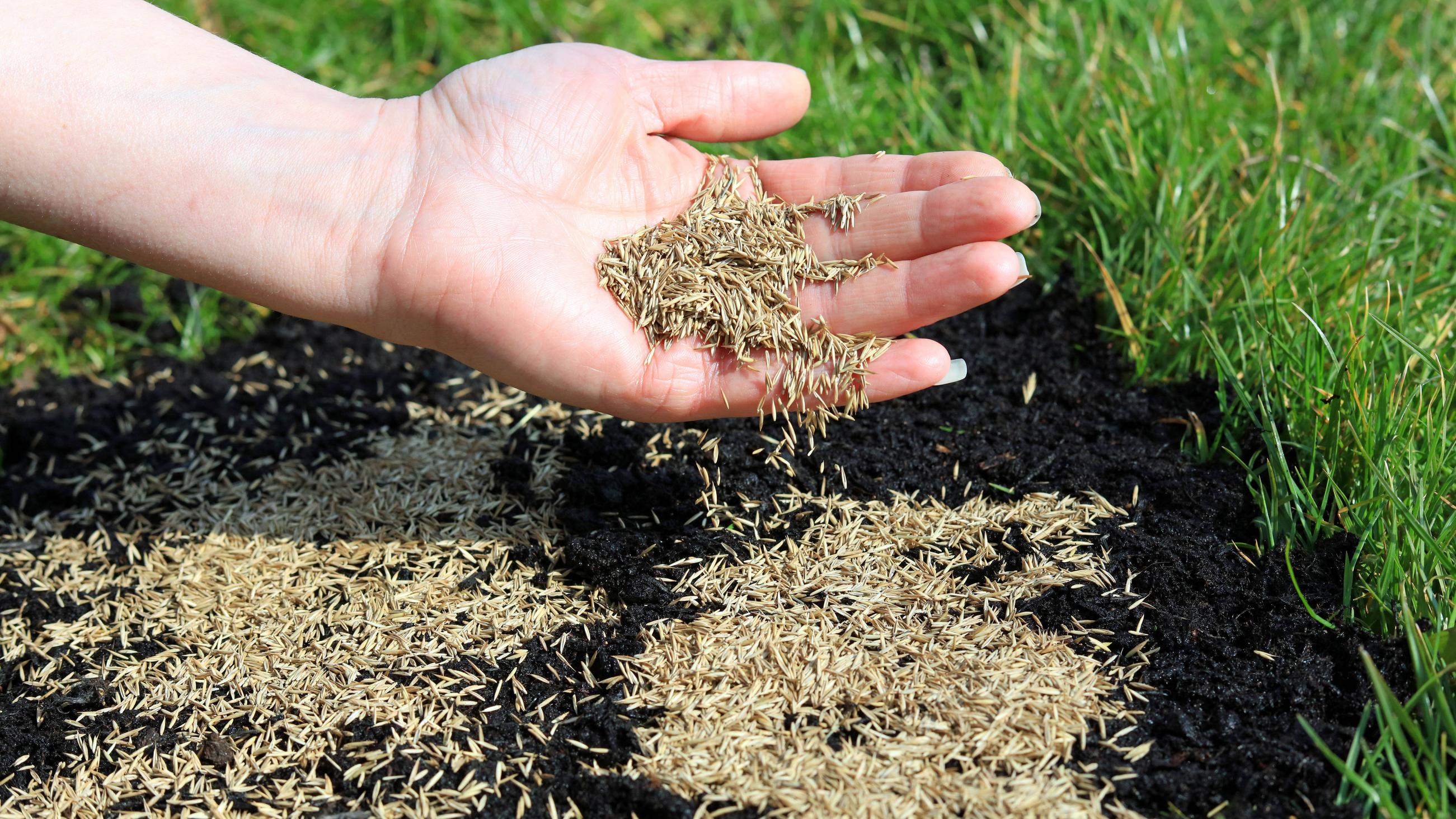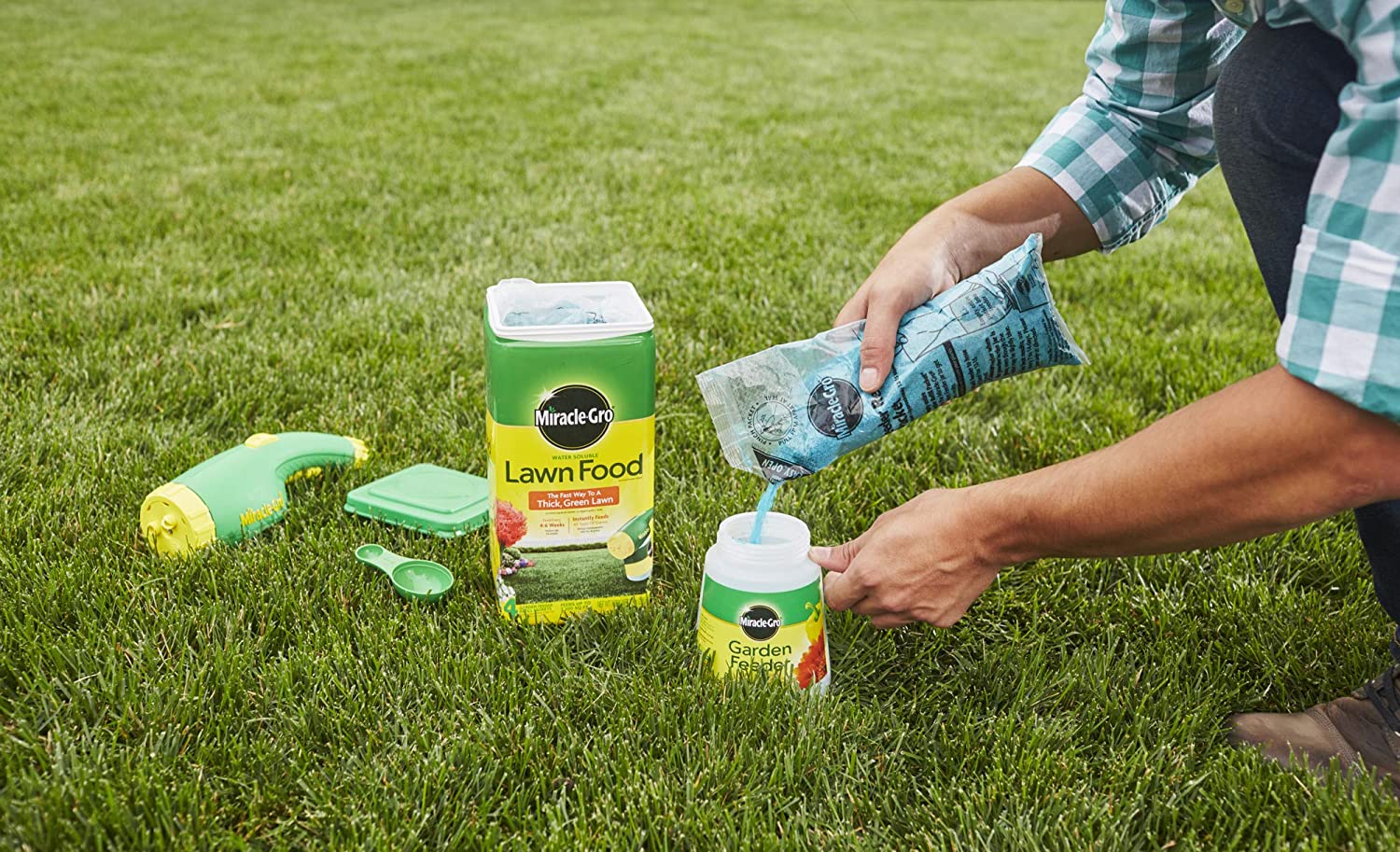Home>Gardening News and Trends>What Fertilizer To Use On New Grass


Gardening News and Trends
What Fertilizer To Use On New Grass
Modified: January 22, 2024
Looking for the latest news on what fertilizer to use on new grass? Get expert advice and tips to ensure a healthy and vibrant lawn.
(Many of the links in this article redirect to a specific reviewed product. Your purchase of these products through affiliate links helps to generate commission for Chicagolandgardening.com, at no extra cost. Learn more)
Table of Contents
- Introduction
- Importance of using the right fertilizer on new grass
- Factors to consider when choosing a fertilizer
- Types of fertilizer recommended for new grass
- Organic fertilizers for new grass
- Synthetic fertilizers for new grass
- Slow-release fertilizers for new grass
- Application tips for fertilizing new grass
- Common mistakes to avoid when fertilizing new grass
- Conclusion
Introduction
Welcome to our comprehensive guide on fertilizing new grass. If you’re a homeowner or a landscaper looking to establish a lush, healthy lawn, you’ve come to the right place. The key to success lies in using the right fertilizer on your new grass. Fertilizers provide essential nutrients that promote healthy growth, strengthen roots, and protect against pests and diseases.
However, it’s important to note that not all fertilizers are created equal, and selecting the right one can make a significant difference in the overall success of your lawn. In this article, we will explore the importance of using the right fertilizer on new grass and discuss various factors to consider when choosing the best fertilizer for your lawn.
Establishing a new lawn requires careful planning and execution, and choosing the right fertilizer is a crucial step in the process. By providing your new grass with the essential nutrients it needs, you can ensure a strong foundation for healthy growth and vibrant green color.
In the following sections, we will delve into the different types of fertilizers available for new grass, including both organic and synthetic options. We will also discuss the benefits of slow-release fertilizers and provide application tips to help you achieve the best results for your lawn.
Before we dive into the specifics, let’s take a closer look at why using the right fertilizer is so important when it comes to establishing new grass. By understanding the role of fertilizers and the impact they can have on your lawn, you’ll be well-equipped to make informed decisions for your specific needs.
Importance of using the right fertilizer on new grass
Choosing the right fertilizer for your new grass is crucial for its proper growth and long-term health. Fertilizers provide essential nutrients that are necessary for healthy plant development. They can enhance root development, strengthen grass blades, and improve overall resilience to environmental stressors.
One of the primary benefits of using the right fertilizer is the promotion of vigorous root growth. Strong roots are essential for the uptake of water and nutrients, enabling the grass to withstand drought conditions and recover quickly from foot traffic or other disturbances. Fertilizers high in phosphorus and potassium are particularly beneficial for root development and overall plant hardiness.
Another important reason to choose the right fertilizer is to maintain a balanced nutrient profile. Different grass species have unique nutrient requirements, and by using a fertilizer specifically formulated for your grass type, you can provide the necessary nutrients in the correct proportions. This helps prevent nutrient deficiencies, which can lead to stunted growth, discoloration, and increased susceptibility to diseases and pests.
Using the right fertilizer also plays a significant role in promoting vibrant green color in your new grass. Fertilizers containing nitrogen are particularly effective in stimulating leaf growth and enhancing the lush appearance of your lawn. By providing an adequate supply of nitrogen, you can achieve that desirable deep green color that makes your lawn stand out.
In addition to supporting growth and color, the right fertilizer can also help protect your new grass from common lawn problems. Fertilizers that contain micronutrients, such as iron, can enhance the grass’s resistance to diseases and pests. They can also improve the overall stress tolerance of the grass, making it more resilient to heat, cold, and other environmental factors.
By using the right fertilizer, you can ensure that your new grass gets off to a strong start and establishes a healthy foundation. Investing in the proper nutrients during the early stages of grass growth can have long-lasting effects, setting the stage for a beautiful and thriving lawn for years to come.
Factors to consider when choosing a fertilizer
Choosing the right fertilizer for your new grass can seem like a daunting task, given the myriad of options available. However, by considering a few key factors, you can simplify the decision-making process and find a fertilizer that best suits your specific needs. Below are some important factors to consider when choosing a fertilizer:
- Grass type: Different grass species have varying nutrient requirements. It’s important to select a fertilizer that is specifically formulated for your grass type to ensure that it receives the necessary nutrients in the correct proportions. Cool-season grasses, such as Kentucky bluegrass or fescue, have different nutrient needs compared to warm-season grasses like Bermuda grass or St. Augustine grass.
- NPK ratio: Fertilizers contain different proportions of nitrogen (N), phosphorus (P), and potassium (K), which are represented by the NPK ratio. The NPK ratio indicates the percentage of each nutrient in the fertilizer. Understanding the nutrient needs of your grass and matching them with the appropriate NPK ratio will help you choose a fertilizer that provides the right balance of nutrients.
- Soil conditions: The composition of your soil can impact nutrient availability for your grass. Conducting a soil test can provide valuable insights into the pH level and nutrient content of your soil. This information will help you select a fertilizer that corrects any deficiencies and optimizes nutrient uptake by your grass.
- Lawn goals: Consider your objectives for your lawn. Are you looking for quick greening, improved root development, or overall health maintenance? Different fertilizers may have specific benefits that align with your goals, so it’s important to choose accordingly. Slow-release fertilizers, for example, provide a steady supply of nutrients over an extended period and are excellent for long-term lawn care.
- Environmental impact: Consider the environmental impact of the fertilizer you choose. Opt for fertilizers that are slow-release or organic, as they are generally more environmentally friendly and reduce the risk of nutrient runoff into nearby water bodies.
By considering these factors, you can narrow down your options and choose a fertilizer that aligns with the specific needs of your new grass. Taking the time to select the right fertilizer will ensure that your grass receives the nutrients it requires for optimal growth and long-term health.
Types of fertilizer recommended for new grass
When it comes to fertilizing new grass, there are various types of fertilizers available to choose from. Each type has its own benefits and considerations. Let’s explore some of the most commonly recommended types of fertilizers for new grass:
- Organic fertilizers: Organic fertilizers are derived from natural sources, such as compost, manure, or plant-based materials. They are generally slow-release, providing a gradual release of nutrients to the grass over time. One of the main advantages of organic fertilizers is that they improve soil fertility and promote the growth of beneficial soil microorganisms. They are also less likely to burn the grass if applied correctly, making them an excellent choice for new grass.
- Synthetic fertilizers: Synthetic or chemical fertilizers are manufactured through a chemical process to provide a concentrated source of nutrients. They typically deliver nutrients quickly to the grass, resulting in rapid greening and growth. Synthetic fertilizers are available in various formulations and can be tailored to provide specific nutrient ratios. They are convenient to use and widely available, but they may require more careful application to prevent over-fertilization and potential harm to the environment.
- Slow-release fertilizers: Slow-release fertilizers are designed to release nutrients gradually over an extended period, typically several months. They provide a steady supply of nutrients to the grass, reducing the risk of nutrient leaching and offering long-lasting effects. Slow-release fertilizers are beneficial for consistent growth and can help minimize the need for frequent applications. They are often recommended for establishing new grass as they support gradual and sustained growth without excessive shoot growth.
- Starter fertilizers: Starter fertilizers are specifically formulated to provide the essential nutrients needed for root development and early plant growth. They are commonly applied when seeding or laying sod for new lawns. Starter fertilizers, often high in phosphorus, are crucial for strong root establishment and promote quick establishment of new grass. They are typically applied at a higher rate during the initial stage of lawn establishment and can help ensure healthy growth from the start.
- Liquid fertilizers: Liquid fertilizers are applied as a liquid solution and are quickly absorbed by the grass through both the leaves and the roots. They provide a fast-acting source of nutrients and are convenient to use, especially for foliar feeding. Liquid fertilizers are particularly beneficial for addressing specific nutrient deficiencies and can be applied more frequently compared to other fertilizer types. However, they may require more frequent application due to their fast-release nature.
When selecting a fertilizer for your new grass, consider your specific needs, budget, and environmental considerations. It’s also important to follow the manufacturer’s instructions for application rates and timing to ensure safe and effective results.
Keep in mind that the choice of fertilizer may vary depending on factors such as grass type, soil conditions, and climate. Consult with a local lawn care expert or extension office for specific recommendations based on your region and grass type.
Organic fertilizers for new grass
Organic fertilizers are an excellent option for fertilizing new grass, as they provide numerous benefits for both the grass and the surrounding environment. Derived from natural sources, such as compost, manure, or plant-based materials, organic fertilizers offer a more sustainable and environmentally friendly approach to lawn care.
One of the key advantages of organic fertilizers is their slow-release nature. They gradually release nutrients into the soil, providing a steady supply of nourishment for the growing grass over an extended period. This slow-release effect helps prevent nutrient leaching and reduces the likelihood of over-fertilization. It also ensures a more balanced and consistent growth of the grass, supporting root development and overall plant health.
Organic fertilizers also contribute to soil fertility and structure. They contain organic matter that improves soil moisture retention, facilitates nutrient absorption, and enhances microbial activity in the soil. This, in turn, promotes a healthier soil ecosystem and aids in the long-term sustainability of the lawn.
In addition, organic fertilizers do not pose the same risk of burning the grass as synthetic fertilizers. They are less concentrated and gentler in their nutrient delivery, reducing the risk of damaging the grass or causing excess growth. This makes organic fertilizers particularly beneficial for new grass, which may be more sensitive during the establishment phase.
There are several types of organic fertilizers to consider for new grass:
- Compost: Compost, often referred to as “black gold,” is a mixture of decomposed organic matter, such as grass clippings, leaves, and kitchen scraps. It is rich in nutrients and beneficial microorganisms, making it an excellent natural fertilizer for new grass. Spread a thick layer of compost on the soil before seeding or apply it as a top dressing to existing grass.
- Manure: Well-aged animal manure, such as cow or chicken manure, is another organic fertilizer option for new grass. It is rich in nutrients and organic matter, providing a slow-releasing source of nourishment. However, it’s important to use composted or well-aged manure to avoid the risk of introducing weed seeds or excess nitrogen that could burn the grass. Apply a thin layer of manure before seeding or incorporate it into the soil.
- Organic lawn fertilizers: There are also commercially available organic fertilizers specifically formulated for lawns. These products typically contain a blend of natural ingredients, such as bone meal, seaweed extract, and blood meal. They provide a balanced nutrient profile and are easy to apply. Follow the manufacturer’s instructions for proper application rates and timing.
- Fish emulsion: Fish emulsion is a liquid organic fertilizer made from fish byproducts. It is rich in nitrogen and other essential nutrients that promote healthy grass growth. Fish emulsion is typically diluted with water and applied as a foliar spray or directly to the soil. It is a quick-acting fertilizer option for new grass that can help with rapid greening.
When using organic fertilizers, it’s important to note that they may take longer to show results compared to synthetic fertilizers. However, their long-term benefits to soil health and the environment make them a preferred choice for many homeowners. Consider incorporating organic fertilizers as part of your overall lawn care routine to ensure a sustainable and vibrant lawn.
Synthetic fertilizers for new grass
Synthetic fertilizers, also known as chemical fertilizers, are a popular option for fertilizing new grass due to their convenience and ability to provide quick and targeted nutrient delivery. These fertilizers are manufactured through a chemical process, resulting in concentrated nutrient formulations that are readily available to the grass.
One of the primary advantages of synthetic fertilizers is their fast-acting nature. They deliver nutrients to the grass quickly, resulting in rapid greening and growth. This can be particularly beneficial when establishing a new lawn and desiring visible results in a shorter time frame.
Synthetic fertilizers offer precise control over nutrient ratios and concentrations, allowing for specific customization based on the needs of the grass. Different formulations are available to address varying nutrient requirements and growth stages. They can be particularly useful when targeting specific deficiencies or adjusting nutrient levels based on soil testing.
Another advantage of synthetic fertilizers is their convenience and ease of application. They are available as granules, pellets, or soluble powders that can be applied with spreaders or dissolved in water for foliar application. Synthetic fertilizers also have a longer shelf life compared to organic options, making them a more practical choice for storage and long-term use.
While synthetic fertilizers offer certain benefits, it’s important to use them responsibly to avoid potential drawbacks. One of the main concerns with synthetic fertilizers is the potential for nutrient runoff, which can lead to water pollution in nearby bodies of water. To mitigate this, it’s crucial to apply synthetic fertilizers according to the manufacturer’s instructions and avoid over-application. Consider using slow-release or controlled-release synthetic fertilizers to minimize the risk of nutrient leaching.
When selecting a synthetic fertilizer for new grass, consider the NPK ratio (nitrogen, phosphorus, potassium) as well as additional micronutrients that may be beneficial for your specific grass type and soil conditions. It’s also important to carefully follow the recommended application rates and timings to prevent excessive nutrient buildup, which can harm the grass and the environment.
If you choose to use synthetic fertilizers, it’s still beneficial to incorporate organic practices alongside their use. For example, regular aeration, proper watering techniques, and regular mowing can all contribute to the health and vitality of your lawn, even when using synthetic fertilizers as a supplement.
Ultimately, the choice between organic and synthetic fertilizers for new grass depends on your personal preferences, environmental considerations, and specific needs. Consulting with a lawn care professional or local extension office can provide valuable insights and recommendations based on your specific grass type and local conditions.
Slow-release fertilizers for new grass
Slow-release fertilizers are an excellent option for fertilizing new grass as they provide a steady and controlled release of nutrients over an extended period. These fertilizers are designed to gradually break down and release nutrients to the grass, ensuring a consistent supply of nourishment for healthy growth.
One of the key advantages of slow-release fertilizers is their ability to prevent nutrient leaching. Unlike fast-release fertilizers that can quickly wash away with watering or heavy rainfall, slow-release fertilizers release nutrients gradually, reducing the risk of nutrient runoff. This not only ensures that the grass receives a steady supply of nutrients but also minimizes environmental impact by reducing the pollution of nearby water sources.
The controlled-release of nutrients by slow-release fertilizers is also beneficial for promoting sustained growth and reducing the need for frequent applications. This can be particularly advantageous for new grass, as it allows for a gradual establishment without excessive shoot growth. Slow-release fertilizers are often formulated with a polymer coating or other mechanisms that regulate and prolong nutrient release, providing sustained nourishment to the grass over a longer period.
Another advantage of slow-release fertilizers for new grass is their reduced risk of burning or damaging the grass. The controlled release of nutrients helps prevent nutrient concentration spikes that can harm the grass or cause excessive growth. This gentle and steady delivery of nutrients also promotes more balanced root and shoot growth, enhancing overall plant health during the critical establishment phase.
It’s important to note that slow-release fertilizers may take longer to show visible results compared to fast-release options. However, the benefits of their gradual and sustained nutrient release make them an attractive choice for long-term lawn care and maintenance.
When choosing a slow-release fertilizer for your new grass, consider the specific nutrient requirements of your grass species. Look for slow-release fertilizers with a balanced NPK ratio and additional micronutrients that promote overall health and vigor. Follow the manufacturer’s instructions for application rates, taking into account factors such as soil conditions, grass type, and climate.
In addition to slow-release granular fertilizers, there are also controlled-release fertilizer formulations available. Controlled-release fertilizers are engineered to provide specific release patterns based on temperature, microbial activity, or other factors. These fertilizers offer even greater control over nutrient delivery, ensuring the grass receives the right amount of nutrients at the right time.
Using slow-release fertilizers for new grass not only supports healthy growth but also reduces the frequency of fertilizer applications. This makes it a convenient option for homeowners and helps maintain a consistent nutrient supply to the grass. Incorporate slow-release fertilizers into your lawn care routine to establish a strong and vibrant lawn that will thrive for years to come.
Application tips for fertilizing new grass
When it comes to fertilizing new grass, proper application techniques play a crucial role in achieving optimal results. Here are some important tips to consider when applying fertilizer to your new grass:
- Timing: The timing of fertilizer application is crucial. For newly seeded lawns, it’s best to wait until the grass has established root growth before applying any fertilizer. This typically occurs after the second or third mowing. For newly sodded lawns, wait at least two weeks before applying fertilizer to allow the sod to settle and establish good root growth.
- Follow the label instructions: Always read and follow the manufacturer’s instructions on the fertilizer packaging. Pay attention to recommended application rates, as using too much fertilizer can lead to burning the grass or environmental pollution. Applying too little may not provide adequate nutrients for healthy growth.
- Spread uniformly: Use a spreader or a handheld applicator to ensure even distribution of the fertilizer. This helps prevent uneven growth and ensures that all areas of the lawn receive a proper amount of nutrients. Pay extra attention to edges and hard-to-reach areas to avoid over or under application.
- Avoid overlapping: When applying fertilizer, try to avoid overlapping the application paths. Overlapping can result in double doses of fertilizer, which can lead to excessive nutrient buildup and potential harm to the grass. If using a spreader, start at the perimeter of the lawn and move in parallel lines for an even distribution.
- Water after application: After applying the fertilizer, it’s essential to water the grass thoroughly. This helps activate the fertilizer, aids in nutrient absorption by the roots, and prevents the fertilizer from sitting on the grass blades, potentially causing burning. Watering also reduces the risk of nutrient runoff and ensures the fertilizer reaches the soil where it is needed most.
- Proper equipment maintenance: Keep your spreader or applicator in good working condition. Clean it thoroughly after each use to prevent the buildup of fertilizer residue, which can affect future applications. Regularly check and calibrate your spreader to ensure accurate and consistent fertilizer distribution.
- Consider the weather: Fertilizing new grass is most effective when done during the growing season and under favorable weather conditions. Avoid fertilizing during extreme heat, drought, or heavy rainfall, as these conditions can stress the grass and reduce nutrient uptake. Ideal temperature ranges and weather conditions may vary for different grass species, so consider consulting with a local expert for specific recommendations.
- Maintain proper mowing and watering: While fertilizers provide essential nutrients, they should be used in conjunction with proper mowing and watering practices. Regular mowing at the recommended height and proper watering techniques help ensure that the grass can effectively utilize the nutrients provided by the fertilizer, promoting optimal growth and health.
By following these application tips, you can ensure that your new grass receives the right amount of nutrients for healthy growth and establish strong roots. Remember, it’s essential to consider the specific needs of your grass type, soil conditions, and climate when determining the ideal fertilizer and application schedule.
Common mistakes to avoid when fertilizing new grass
Fertilizing new grass is a critical step in establishing a healthy lawn. However, there are several common mistakes that people make when applying fertilizer that can hinder the growth and overall health of the new grass. To ensure successful results, it’s important to avoid these common mistakes:
- Over-application: Applying too much fertilizer is a common mistake that can harm the new grass. Using excessive amounts of fertilizer can lead to nutrient burn, resulting in yellow or brown patches on the lawn. It can also cause excessive shoot growth, making the grass more susceptible to disease and pest infestations. Always follow the recommended application rates on the fertilizer packaging and avoid the temptation to apply more.
- Under-application: Conversely, under-applying fertilizer can result in nutrient deficiencies and poor growth. Fertilizer provides essential nutrients that new grass needs for healthy development. Applying too little fertilizer can lead to weak root growth, thin grass, and inadequate nutrient uptake. Make sure to follow the recommended application rates to provide the necessary nutrients for the new grass without overdoing it.
- Applying fertilizer to wet grass: Applying fertilizer to wet grass can lead to uneven distribution and clumping, making it difficult for the grass to absorb the nutrients effectively. Wait until the grass is dry before applying fertilizer to ensure it spreads evenly and adheres properly to the soil surface.
- Ignoring soil conditions: Soil conditions play a crucial role in nutrient availability and grass growth. Ignoring the soil’s pH level, nutrient content, and compaction can hinder the effectiveness of the fertilizer application. Conduct a soil test prior to fertilizing to determine any necessary amendments or adjustments to optimize nutrient uptake.
- Not incorporating organic matter: Organic matter, such as compost or grass clippings, can greatly benefit new grass by improving soil structure and fertility. Failing to incorporate organic matter into the soil before or after fertilizing can limit the grass’s access to essential nutrients and hinder overall growth. Consider adding a layer of compost or using organic fertilizers to provide additional organic matter and promote long-term soil health.
- Applying fertilizer near water bodies: Fertilizer runoff into nearby water bodies can cause pollution and harm aquatic ecosystems. Avoid applying fertilizer too close to ponds, streams, or other water sources to prevent nutrient runoff. Leave a buffer zone between the lawn and water bodies to minimize the risk of contamination.
- Not following the recommended schedule: Fertilizing new grass requires thoughtful timing and adherence to recommended schedules. Skipping or delaying fertilization can deprive the grass of vital nutrients during critical growth periods. Make sure to follow the recommended fertilization schedule based on the grass type, local climate, and specific fertilizer used.
- Using the wrong type of fertilizer: Different grass species have unique nutrient requirements. Using the wrong type of fertilizer or one that is not appropriate for your particular grass type can lead to nutrient imbalances or deficiencies. Do some research or consult with a lawn care professional to choose a fertilizer that matches the specific needs of your new grass.
By avoiding these common mistakes, you can ensure that your new grass receives the appropriate nutrients and establishes a strong and healthy foundation for long-term growth. Take the time to plan and execute proper fertilization practices to set your lawn up for success.
Conclusion
Fertilizing new grass is a critical step in establishing a vibrant and healthy lawn. By choosing the right fertilizer and applying it correctly, you can provide your new grass with the necessary nutrients for optimal growth and long-term health. Consider the specific needs of your grass type, soil conditions, and climate when selecting a fertilizer, whether it’s organic or synthetic.
Factors such as grass type, NPK ratio, and slow-release properties should guide your decision-making process. Organic fertilizers offer sustainability and soil health benefits, while synthetic fertilizers provide quick results and precise nutrient control. Slow-release fertilizers are excellent options for consistent growth and reduced frequency of applications.
When applying fertilizer, take care to follow the manufacturer’s instructions, spread it evenly, and water the grass thoroughly afterward. Avoid common mistakes such as over-applying or under-applying fertilizer, applying to wet grass, or ignoring soil conditions. Maintaining proper mowing, watering, and fertilizing practices will ultimately lead to a lush and resilient lawn.
Remember, establishing a new lawn requires patience and proper care. Regular monitoring of your lawn’s progress and adjusting fertilization practices accordingly will help you achieve the desired results. Additionally, integrating organic practices, such as incorporating organic matter and following environmentally-conscious practices, will contribute to the long-term health of your lawn and the surrounding ecosystem.
By implementing these strategies and avoiding common pitfalls, you can ensure your new grass establishes a strong and beautiful lawn that will be the envy of the neighborhood. Regular maintenance and periodic fertilization will keep your lawn thriving for years to come, providing you with a lush, green space to enjoy and appreciate.










